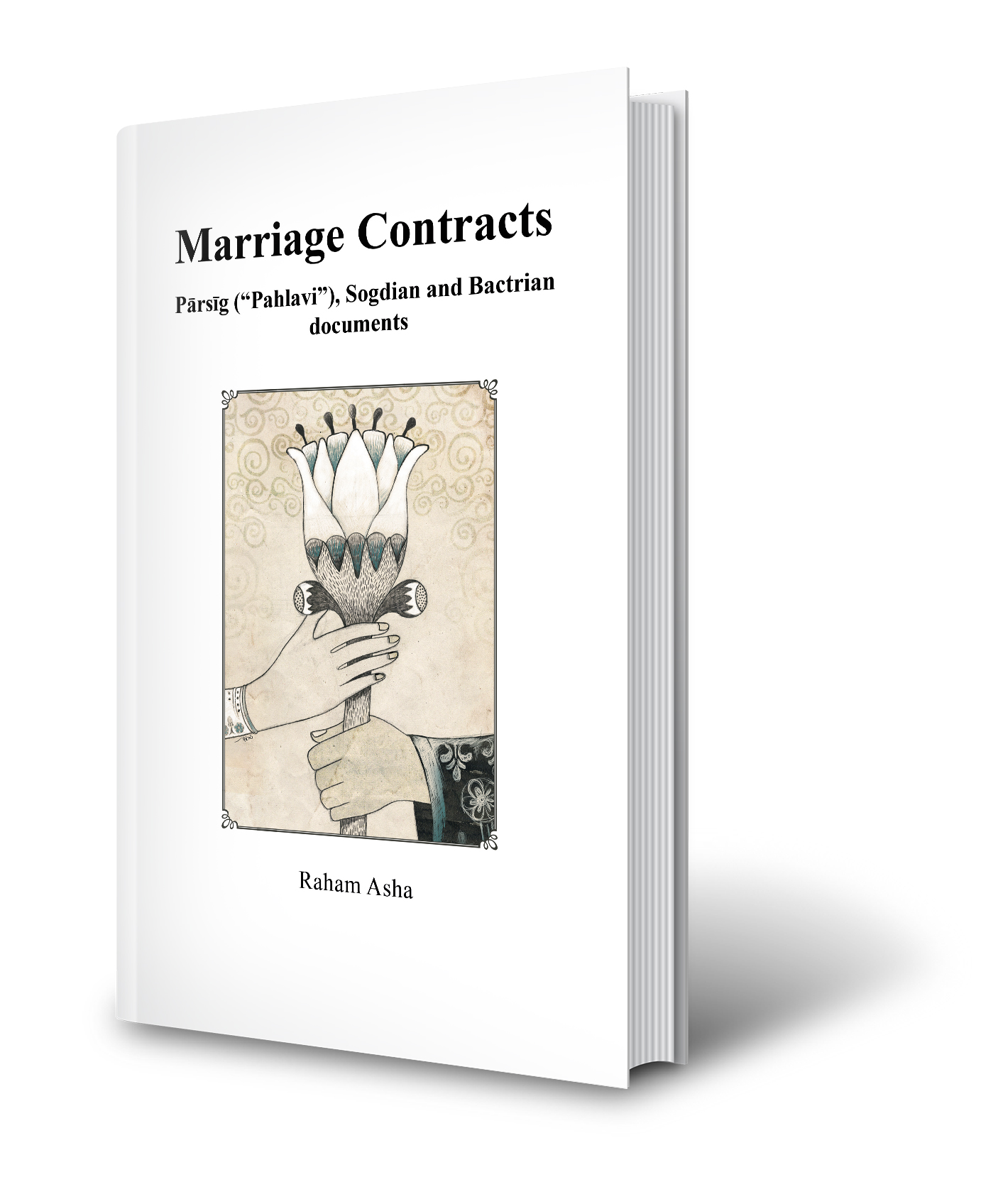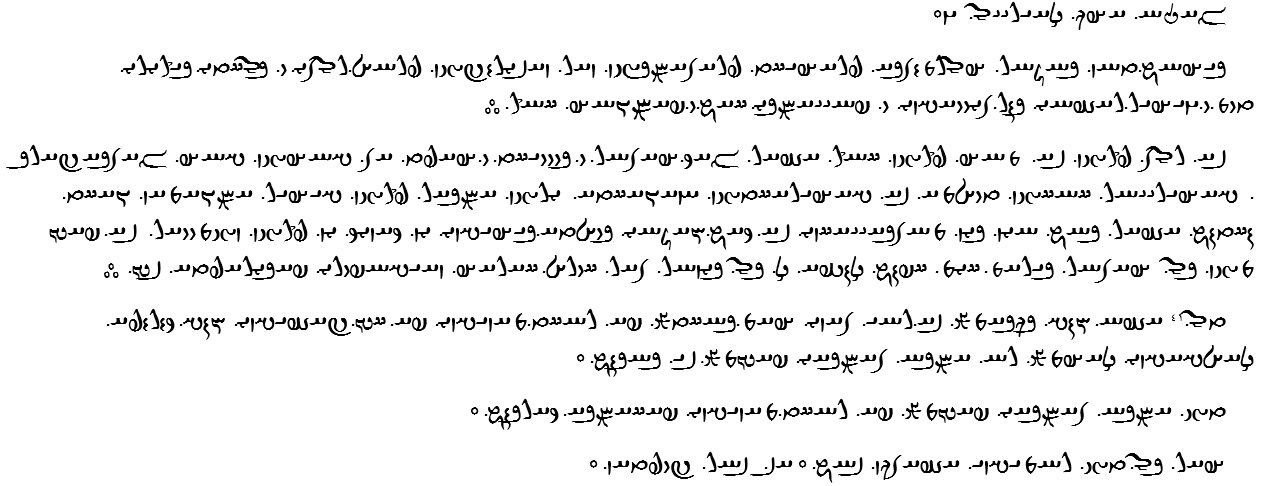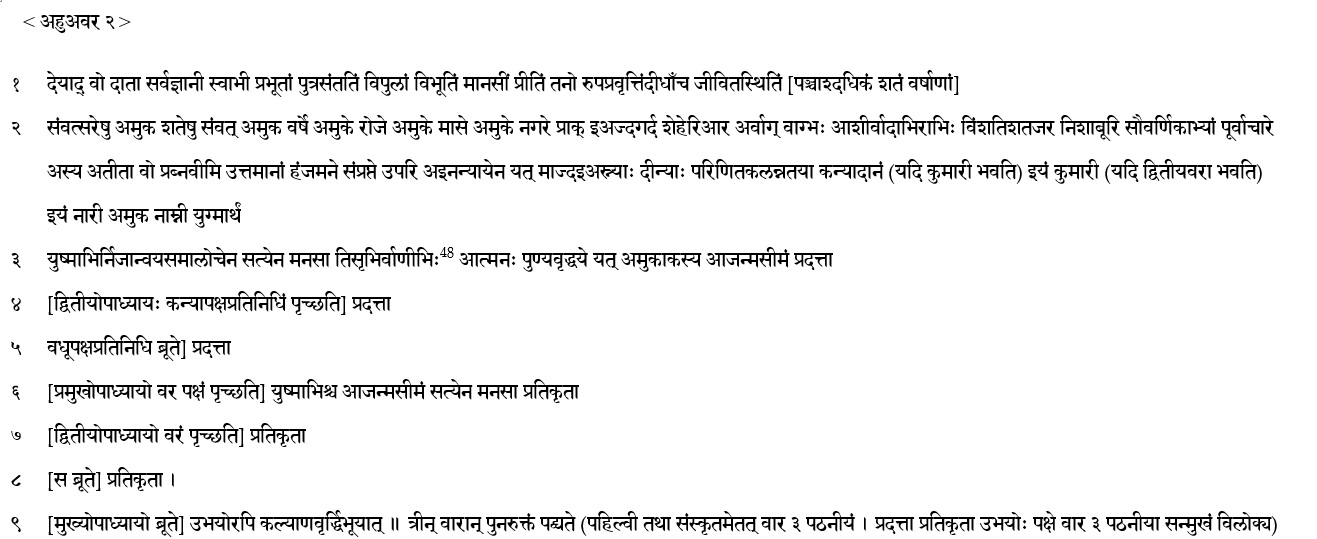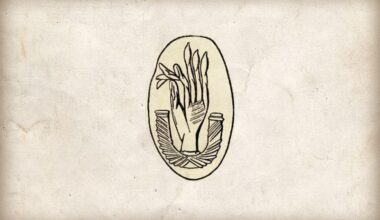Raham Asha, Marriage Contracts: Pārsīg (“Pahlavi”), Sogdian and Bactrian documents, First published, Dushanbe, Academy of Sciences, Tehran, Shourafarin, 2020, ISBN 978-622-6657-90-7; Second published, Arrou, Alain Mole, 2021, ISBN 978-2-9579653-1-1, EAN 9782957965311.
Note to the Second Edition
It is now only one year since publication of the first edition of the Marriage Contracts. For this new edition the book has been slightly reset. Many thanks go to my colleague Mr. Razmik Yeghnazary for providing me a means to type Sogdian texts.
Ohrmazd rōz ī Xordād māh, 1391 Y.
Note to the First Edition
The aim here is to provide a collection of documents relating to marriage in ancient times as preserved to us in Aryan languages ˗Bactrian, Sogdian and Pārsīg (“Pahlavi”). As it is compiled with the needs of the students of the Faculty of Philology in Samarkand and those involved with linguistics at the Academy of Sciences in Dushanbe, it provides etymological and explanatory notes, adapted to the needs and knowledge of the student who has already had his first training in Aryan languages.
Special thanks go to the Academy of Sciences, Dushanbe, and to the Faculty of Philology, Samarkand, for their cordial welcome.
I should like to thank Yuliya Biryukova who has sent me copies of some documents from Saint Petersburg. As for the helpfulness and efficiency of Bozorgmehr Loghman and Mazda Tajbakhsh, zār βrēvar ǝspās.
Raham Asha
Urdēvahišt rōz ī Ābān māh, 1389 Y. (15 February 2020)
Contents
List of abbreviations 9
Introduction 15
Texts, Transcriptions and translations
Pārsīg (« Pahlavi »)
I. peymān ī zanīh 35
II. peymān ī kadagxvadāyīh 53
Sogdian
Nov. 3 93
Nov. 4 111
Āfrivan 121
Bactrian
A
ολοβωστογο 137
Introduction
Perso-Aryan marriage contracts
The texts presented here provide some needed information about the legal position of the wife in the first millennium A.D.
We know by now marriage contracts in the Perso-Aryan world written in three different Aryan languages:
- One comes from Bactria, is written in Bactrian, and dates back to the fourth century (Bact. A).
- The other comes from noble backgrounds in Samarkand, is found on Mount Muγ, is written in Sogdian, and dates back to the early eighth century. It is indeed a marriage contract (Nov. 3) together with the accompanying guarantee letter (Nov. 4).
- There are also two model marriage contracts compiled in Pārsīg, one in Persia, and the other in India, which reflect the actual practices of those of the Good Religion in the Sasanian times and after.
The word for “contract” is, in Pārsīg, pašt or peymān[1]. In the Pārsīg document of Persia the term peymān ī zanīh is used to indicate the “marriage contract”.[2] The Parsis of India use a model contract marriage, commonly known as āširvād paimān.[3] The text of Āširvād is recited by two officiating priests. First, they ask questions from the father of the bridegroom, the father of the bride, and also from the couple (kadagxvadāy ud kenīg) ˗ this is the part of the marriage contract. Then, the part of the priests’ benediction starts. The “marriage contract/ certificate” is called, in Sogdian, vuδ-karnē[4], and in Bactrian, ολοβωστογο[5] ˗these words confirm that Sogdian pōstē[6] (or, karnē, or Bactrian πωστογο, or Persian peyvann-nāmag) in the legal sense of “marriage contract” should be in written form.[7]
As we see from the three marriage contracts (except the model prenup of the Pārsīs of India), wedding in Ērānšahr was primarily a civil ceremony. The main purpose of the “marriage certificate” was to safeguard the rights of the spouses. Apart from the “contract”, marriage needed to be sanctioned by a religious ceremony in which some texts of benediction were recited.[8] The Aryan word for “benediction” is *āfriHu̯ana-.[9] One text of benediction in Sogdian (found in Chinese Turkestān) reveals to be similar to the Āfrīn ī Vazurgān recited in wedding ceremonies of the Pārsīs. In general, the “civil” contract was preferably written, while the “religious” rite of benediction was often oral. The custom of written contracts was already well established among the various Perso-Aryans probably since the Achaemenian period.
The conclusion of a marriage agreement needed successive steps, the matrimonial suit, the conclusion of marriage, etc. The issues concerning matrimonial donation, dowry, divorce, inheritance rights should be concluded before the final act.[10] They are parts of the family law in the Perso-Aryan world.
The future spouse, being in the company of his father or an old member of the family, presented himself as a petitioner to the girl’s house, asking her guardian for her hand in marriage. There is a story about the wedding proposal of Zaraθuštra that can be regarded as a model:
‘About: The right choice of a wife according to his own desire, and also the will of his parents; one should not mingle his seed before a proper finding.
This, too, is revealed (in the Avesta[11]) that: When his father asked a wife in marriage for him, Zaraθuštra argued thus: “Show me your face!” [that is[12]: so that he could check her appearance, fashion and form, whether her appearance is lovely or not].
But the woman turned away her face from him.
Then Zaraθuštra spoke thus: “whoever does not allow me to look at her, does not cultivate respect[13] for me.”’[14]
The request of the father bringing his son to the house of the bride is followed by the formula expressed by the father as well as by the son; in this way, the bride becomes “daughter-in-law”[15] and at the same time “wife”, and the procedure is called, in Pārsīg, duxtagānīh (lit. ‘adoption as a daughter’)[16] as well as zanīh (lit. ‘womanhood’). In the Pārsīg and Sogdian texts, the bridegroom addresses to the father (or, guardian) of the bride, and not directly to her. The solemn formula in the Bactrian document is a little different: The young man, without addressing the father or guardian of the girl, states that he takes the young woman like a spouse.
The Sogdian document contains stipulations referring to the dissolution of marriage by divorce.[17] The contract grants a wife the right to take the initiative to demand divorce in the same way as the husband. The same document gives two separate clauses, one concerning divorce initiated by the husband and the other concerning divorce initiated by the wife.
According to the Sogdian document, the marriage was monogamous in the sense that the husband could not take a second legitimate wife.[18] This stipulation did not exclude the possibility, for the man, of taking a concubine without the title of “legitimate” wife. On the other hand, the wife could refuse to allow him this possibility, claim a financial indemnity from him, and demand the ouster of the second wife or concubine.
The bride, after marriage, will become kadagbānūg, the mistress of the house, the mater familias. Pārsīg, Sogdian and Bactrian texts similarly call her “entitled” or “legitimate” wife: zan ī pādixšā, pātǝxšāvǝn vaδu, ϕινζο ϕρομανζο. This type of matrimony was with full matrimonial rights (matrimonium cum manu, Pers. zanīh ī pādixšāyīhā), i.e., the wife and the husband will inherit one another, the children are entitled to inherit their parent’s property, and the sons become legal successors of the father.
According to the Pārsīg text, in the cum manu marriage (pādixšāyīhā-zanīh) it is the husband’s duty to ensure his wife a decent and easy life. The bridegroom not only gives the bridegroom full right to an income, but he even promises a gift from his property, half of it in advance in an undivided state, and half in cases of breakup of the marriage. The amount of the gift is subject to the approval of the bride.[19] The Pārsīg word for this bridal gift is kābēn.[20]
Another kind of matrimonial donation is dowry. The word for “dowry” is, in Bactrian, ναμαγγο. This word reflects Av. nāmǝni– f. ‘share’ from nam ‘to share, allocate’ (nǝmah– nt. ‘loan’) which is glossed by Pers. vāspuhragān pas(dād)agān.[21]
In Sogdian, the word for “wedding” is βaγānīpǝšǝkǝrtē (or, βaγānīšpǝktē). The first part of this word, βaγ-, means ‘lord; god’; and while βaγānīpǝš literally means ‘divine son’[22], however it denotes ‘bridegroom, son-in-law’ and corresponds with Pers. kadag-xvadāy. Then βaγānēpǝšǝkǝrtē has nothing to do with βaγ– < *baga– ‘god’, but merely means ‘bridegroom-making, wedding’[23], corresponding with Pers. kadagxvadāyīh or vayū(da)gān.[24]
There is a special form of legitimate marriage called, in Pārsīg, The first element in the word is not bay/ baγ ‘god’ but bi° ‘two°’, and the whole word should be read biyaspān[25], continuing old Aryan *bi-(h)aspāna-, cf. Pers. (h)asp– ‘to rest, sleep’.[26] In this kind of marriage, the agreement was between two people only, the bride (without the consent of her guardian) and her lover (gādār).[27] Another term for this kind of marriage is xvasrāyēnīh.[28] It may be the reminiscent of an older tradition of marriage by self-choice, practised among the “warriors”, as we can find in Persian stories (there was an open competition in this kind of marriage and the girl selected the best).[29]
Bactrian Customs
Bardesan in the Book of the Laws of Countries (ܟܬܒܐ ܕܢܡ̈ܘܣܐ ܕܐܬܪ̈ܘܬܐ) speaks about the Bactrians and gives some common stereotypes of his time ˗ and, of course, like most stereotypes, these are doomed to inaccuracy.
“Laws of the Bactrians[30]:
Among the Bactrians, who are (also) called the Kushans[31], the women are dressed in her finest clothing like men, adorned with much gold and precious gems. The men-servants and maid-servants serve them rather than their husbands. They (the Bactrian women) ride on mares decked out with ornamental equipment of gold and with precious stones. However, these women do not observe chastity, but have (sexual) intercourse with their men-servants, and (also) with strangers who come to this country. Their husbands do not reproach them, and the women have no fears in this regard; because the Kushans look at their wives like mistresses.
However, we cannot say that for all the Bactrian women Venus is placed, together with Mars and Jupiter, in the house of Mars in the midst of sky (i.e. the meridian), where women that are wealthy, adulterous, and dominate their husbands in everything, are born.”[32]
The Bactrian document A is the (oldest) polyandric marriage contract.[33] This reminds us of the custom of polyandry among the Hephtalites as described in the Chinese sources.[34] For example, in the Book of Zhōu
(周書) it is said thus:
“Brothers conjointly take a wife. If the husband has no brother, then the wife puts on a hat with one horn; if he has brothers, the number of horns is added (compared to the number of brothers).”[35]
The arrival of Hephtalites in Bactria was one century after the above marriage record. This means that the Bactrians did not borrow the custom of polyandry from the Hephtalites.
A Pārsīg example: peymān ī zanīh
There is a model marriage contract extant in Pārsīg; the copyist has added the date 647 A.Y. (/ 1278 A.D.) of copying to it.[36] This text is a good example of the entitled-marriage contract of the Sasanian times, and its terminology is completely in line with that of the Zand of the Avesta.
The Pārsīg Marriage Contract was contained in the Codex MK (copied in 1322). It was edited by Jamaspji Minocheherji Jamasp-Asana.[37]
Another Pārsīg example: peymānag ī kadagxvadāyīh
The original Pārsīg text of the peymān (and the two following Āfrīn) is not extant. In the Zand of the Short Liturgies (Xvardag Abestāg)[38] the Pārsīg text of the solemn promises and recitals of blessings at the marriage ceremony seems to be “an attempt” at reconstructing the original text based on a Pāzand version.[39] The last copy of that text was made in the year 767 A.Y. (/ 1397-98 A.D.). We find a Pārsīg version (called by the Parsis Āširvād Paimānī) based on the original in a number of manuscripts of the Zand ī Xvarda Avesta. It was first edited, based on two manuscripts, by Dhabhar.
Pāzand versions: peyvann rāyēnīdārīh
The Parsis of India transcribed it in Avesta script so that the priests could read it more easily. This is the so-called Pāzand text which the Parsi priests use in the actual marriage service. In Persia the Irani priests also used Avesta script (and sometimes Persian script) to write the marriage contract and some benediction-texts recited on the occasion of marriage ceremonies.
We find both Pāzand versions, one for the ceremony as performed in Iran, and the other for the ceremony as performed in India, as well as some other benediction-texts on the occasion of marriage ceremonies, in a number of manuscripts.[40]
Here is the “legal” section:
A Sanskrit version
The Parsis used to perform the marriage ceremony twice: once, in Pāzand, in the early morning in accord with Aryan usage; and for a second time, in Sanskrit, after sunset according to Indian tradition. Tradition has it that when the Parsis first emigrated to India, they promised to Jādi Rāṇā to perform a marriage ceremony after sunset and conduct it in the language of the court, Sanskrit. The Sanskrit version corresponds more closely to the original text than the Pāzand version, and is much older than the latter. This text is called the विवाहस्य पइमांनी or simply आशीर्वाद ‘benediction’.[42] In the beginning it is said that the text was made by a certain Bahman[43] from the “Pahlavi” text:
इयं विवाहस्य पइमांनी संस्कृतभाषायां पहिल्वी भाषायाः दीनिदारु बह्म्नेन अवतारिता ॥[44]
The earliest manuscript which has quoted him as the translator of the Pārsīg Marriage Contract dates back to Saṁvat 14 . . (784 A.Y.).[45] The piece is imperfect, and the translation awkward.[46] The Sanskrit contract was first edited by Bharucha, and then by Taraporewala.[47]
Here is the “legal” section:
Sogdian documents : vuδkarnē ǝt nāmē
In the archives of Dēvāštīc and his associates preserved in the castle of Mount Muγ (kōh ī muγ), lying east of Panjikent and Samarkand, one finds two parchment manuscripts, written in Sogdian, concerning the marriage of a couple, Ottegin and Čata, celebrated in Samarkand in the first decade of the 8th century: one (Nov. 3), the text of the marriage agreement itself; and the other (Nov. 4), the subsidiary “bride’s document”, in which the bridegroom declares his acceptance and states his obligations, by addressing the head of the bride’s family. The parties to the marriage contract are, like the Pārsīg model, the bridegroom (N1), on the one hand, and the father or guardian of the bride (N5), on the other. These documents are written by the same scribe, Rāmtiš, on the same day.[49]
A benediction-text in Sogdian: āfrivan
Among the Sogdian texts of the Ôtani collection preserved in the National Museum of Lüshun (Dalian), one finds a fragment of an Āfrivan. It is similar to Avesta and Pārsīg benediction-texts. It seems that a Buddhist scribe has copied an older Sogdian text by adding a few phrases. The original text was probably recited by Sogdian priests in ceremonies on the occasion of birth, marriage, or the like. We insert the fragment L[üshun] M[useum] 20: 1480/ 22 (02) to compare it with the Avesta and Pārsīg blessing-texts.[50]
A Bactrian Marriage Contract: ολοβωστογο[51]
Among the dated legal documents in Bactrian there is a marriage contract dated in the year 110, on the tenth day of the second month. If the Kushano(-Sasanian) era be 233 A.D.[52], then the marriage took place in 343, October 6, a Thursday. The certificate comes from a precinct of the town Rōb.
For notes see: Marriage Contracts: Pārsīg (“Pahlavi”), Sogdian and Bactrian documents, pp 15-34.
Purchase
For individuals situated within Iran, the book is available for acquisition at the designated address.
For those located outside Iran, it is advisable to forward your request via email to the Perso-Aryan Studies email address provided below:
PersoAryanStudies@gmail.com








